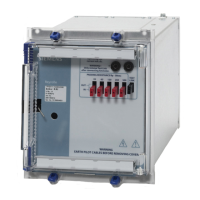7PG21 Solkor Rf Commissioning
©2012 Siemens Protection Devices Limited Chapter 6 Page 14 of 21
3. Pilot Supervision Equipment
3.1 Introduction
Prior to 1988 pilot supervision was only available in the Vedette drawout case and this equipment was
manufactured suitable for 15kV Insulated pilot circuits. Thus it can be applied to both 5kV and 15kV schemes.
Since 1988 it is now possible to purchase pilot supervision in Epsilon modular cases, however these cases are
restricted for use on 5kV insulated pilot circuits
.
3.2 Description of equipment
The supervision equipment comprises:-
a) At the supervision supply end:-
One transformer - rectifier supervision supply unit
One supervision supply failure relay (if required)
b) At the supervision receive end:-
One pilot supervision receive relay
One pilot supervision receive repeat relay
For the 5kV scheme in the Epsilon modular case system, both elements are combines into one size
E4 case.
c) On some installations guard relays are fitted to prevent tripping of the circuit breaker should the Solkor
protection operate under load conditions due to the pilots becoming open circuited.
The operating coils of the guard relays are connected in series with the summation transformer at each end of the
feeder and the contacts of the guard relays are in series with the Solkor tripping contacts.
The setting of the phase fault guard relays should be lower than one half of the minimum phase fault current
available and higher than the maximum available load current.
The setting of the earth fault guard relay which is connected in the neutral lead of the C.T’s should be lower than
one half of the minimum earth fault current available.
A typical Solkor Rf installation using pilot wire supervision and guard relays is shown in Fig. 8
3.3 Commissioning Tests
Preferably do the tests in the order given below:-
• Check of Connections
• Secondary Wiring Insulation Tests
• Pilot Tests
• C.T. Ratio and Polarity Tests
• Overall Fault Setting Tests
• Tests of Pilot Supervision Relays
• Overall Tests of Pilot Supervision Equipment
• Stability Tests
3.3.1 Check of connections
Make a general check of connections as described in the appropriate Operating Recommendations.
3.3.2 Secondary wiring insulation resistance tests
Check the insulation resistance of the secondary wiring as described in the appropriate Operating
Recommendations
.

